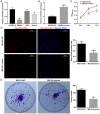miR-363 acts as a tumor suppressor in osteosarcoma cells by inhibiting PDZD2
- PMID: 30896877
- PMCID: PMC6448123
- DOI: 10.3892/or.2019.7078
miR-363 acts as a tumor suppressor in osteosarcoma cells by inhibiting PDZD2
Abstract
PDZ domain containing 2 (PDZD2) is a multi-PDZ domain protein that promotes the proliferation of insulinoma cells, and is upregulated during prostate tumorigenesis. However, the function of PDZD2 in other cancers, including osteosarcoma (OS), remains unclear. Dysregulation of microRNAs (miRNAs) contributes to tumor initiation, proliferation and metastasis, via the regulation of their target genes. The present study investigated the functions of miR-363 and PDZD2 in MG-63 OS cells. The results revealed that MG-63 cells contained low levels of miR-363, and that overexpression of miR-363 in MG-63 cells significantly inhibited the vitality, proliferation, and colony formation ability of the cells, but promoted their apoptosis and G1/S arrest by regulating proliferating cell nuclear antigen (PCNA) and caspase-3 expression. Additionally, miR-363 impaired the migration and invasion of MG-63 cells by regulating the epithelial-mesenchymal transition (EMT) phenotype. Notably, a bioinformatics analysis and luciferase reporter assay indicated that PDZD2 was a direct target of miR-363. miR-363 overexpression reduced PDZD2 protein levels and knockdown of PDZD2 suppressed the colony formation, migration and invasion of MG-63 cells, but promoted their apoptosis by regulating expression of PCNA, caspase-3, and the EMT phenotype. In vivo studies further confirmed that miR-363 functioned as tumor suppressor, by inhibiting tumor growth, promoting cell apoptosis, and reducing PDZD2 and PCNA levels and the prevalence of the EMT phenotype in tumor tissues. The present data demonstrated that downregulation of the tumor suppressor miR-363 may be involved in the development of osteosarcoma via regulation of PDZD2.
Figures






Similar articles
-
MiR-363 suppresses cell migration, invasion, and epithelial-mesenchymal transition of osteosarcoma by binding to NOB1.World J Surg Oncol. 2020 May 1;18(1):83. doi: 10.1186/s12957-020-01859-y. World J Surg Oncol. 2020. PMID: 32357945 Free PMC article.
-
Long Noncoding RNA SNHG7 Promotes the Tumor Growth and Epithelial-to-Mesenchymal Transition via Regulation of miR-34a Signals in Osteosarcoma.Cancer Biother Radiopharm. 2018 Nov;33(9):365-372. doi: 10.1089/cbr.2018.2503. Epub 2018 Jul 10. Cancer Biother Radiopharm. 2018. PMID: 29989838
-
Long Noncoding RNA GAS5 Suppresses Cell Growth and Epithelial-Mesenchymal Transition in Osteosarcoma by Regulating the miR-221/ARHI Pathway.J Cell Biochem. 2017 Dec;118(12):4772-4781. doi: 10.1002/jcb.26145. Epub 2017 Jun 13. J Cell Biochem. 2017. PMID: 28519068
-
Role of miR-142 in the pathogenesis of osteosarcoma and its potential as therapeutic approach.J Cell Biochem. 2019 Apr;120(4):4783-4793. doi: 10.1002/jcb.27857. Epub 2018 Nov 18. J Cell Biochem. 2019. PMID: 30450580 Review.
-
MicroRNA-452: a double-edged sword in multiple human cancers.Clin Transl Oncol. 2023 May;25(5):1189-1206. doi: 10.1007/s12094-022-03041-0. Epub 2023 Jan 9. Clin Transl Oncol. 2023. PMID: 36622551 Review.
Cited by
-
MiR-363 suppresses cell migration, invasion, and epithelial-mesenchymal transition of osteosarcoma by binding to NOB1.World J Surg Oncol. 2020 May 1;18(1):83. doi: 10.1186/s12957-020-01859-y. World J Surg Oncol. 2020. PMID: 32357945 Free PMC article.
-
Mitochondrial fission genes MTFP1/MTFP2 as predictive biomarkers in prostate cancer: a mendelian randomization study.Discov Oncol. 2025 Aug 18;16(1):1579. doi: 10.1007/s12672-025-03215-6. Discov Oncol. 2025. PMID: 40824549 Free PMC article.
-
Regulation of Molecular Targets in Osteosarcoma Treatment.Int J Mol Sci. 2022 Oct 20;23(20):12583. doi: 10.3390/ijms232012583. Int J Mol Sci. 2022. PMID: 36293439 Free PMC article. Review.
-
miR-363-3p induces EMT via the Wnt/β-catenin pathway in glioma cells by targeting CELF2.J Cell Mol Med. 2021 Nov;25(22):10418-10429. doi: 10.1111/jcmm.16970. Epub 2021 Oct 12. J Cell Mol Med. 2021. PMID: 34636136 Free PMC article.
-
Regulation of the Epithelial to Mesenchymal Transition in Osteosarcoma.Biomolecules. 2023 Feb 20;13(2):398. doi: 10.3390/biom13020398. Biomolecules. 2023. PMID: 36830767 Free PMC article. Review.
References
-
- Geller DS, Gorlick R. Osteosarcoma: A review of diagnosis, management, and treatment strategies. Clin Adv Hematol Oncol. 2010;8:705–718. - PubMed
MeSH terms
Substances
LinkOut - more resources
Full Text Sources
Medical
Molecular Biology Databases
Research Materials
Miscellaneous

